
NASA's highly anticipated UFO study is about to begin, and we now know who will conduct it.
In June, the space agency announced that it had commissioned a panel to investigate UFOs, or, as they have recently been rebranded, "unidentified aerial phenomena" (UAP). The independent study will begin in the fall, cost less than $100,000 and last about nine months from start to finish, NASA officials said at the time.
Fall has arrived, and so has the study's start date — nearly, anyway. The panel will begin its work on Monday (Oct. 24), NASA officials wrote in an update today (Oct. 21).
Related: NASA hopes new study helps bring UFO research into the mainstream
The study doesn't aim to be the last word on UFOs. It will look at previously collected UAP observations (the unclassified ones only, leaving out sensitive military data), focusing on how they could be better organized and analyzed in the future to shed more light on mysterious sky sights.
"Exploring the unknown in space and the atmosphere is at the heart of who we are at NASA," Thomas Zurbuchen, associate administrator of the Science Mission Directorate (SMD) at NASA headquarters, said in today's update.
"Understanding the data we have surrounding unidentified aerial phenomena is critical to helping us draw scientific conclusions about what is happening in our skies," he added. "Data is the language of scientists and makes the unexplainable explainable."
Get the Space.com Newsletter
Breaking space news, the latest updates on rocket launches, skywatching events and more!
We already knew that the study team will be chaired by astrophysicist David Spergel, president of the Simons Foundation, and that the NASA official orchestrating the effort is Daniel Evans, the assistant deputy associate administrator for research at the SMD.
But today's update revealed the full team. There will be 16 investigators from a variety of fields, from astronomy to oceanography to computer science to journalism. There's even a former NASA astronaut in the bunch.
In addition to Spergel, the team members are (in alphabetical order):
- Anamaria Berea, associate professor of computational and data science at George Mason University, research affiliate with the SETI Institute in Mountain View, California, and research investigator with Blue Marble Space Institute of Science in Seattle;
- Federica Bianco, joint professor at the University of Delaware in the Department of Physics and Astrophysics, the Biden School of Public Policy and Administration and the Urban Observatory;
- Paula Bontempi, dean of the Graduate School of Oceanography at the University of Rhode Island (URI) and a professor of oceanography at URI;
- Reggie Brothers, operating partner at AE Industrial Partners in Boca Raton, Florida and formerly CEO and board member of BigBear.ai in Columbia, Maryland;
- Jen Buss, CEO of the Potomac Institute of Policy Studies in Arlington, Virginia;
- Nadia Drake, freelance science journalist and contributing writer at National Geographic;
- Mike Gold, executive vice president of Civil Space and External Affairs at Redwire in Jacksonville, Florida and previously NASA associate administrator for Space Policy and Partnerships;
- David Grinspoon, senior scientist at the Planetary Science Institute in Tucson, Arizona, and a frequent advisor to NASA on space exploration;
- Scott Kelly, former NASA astronaut, test pilot, fighter pilot and retired U.S. Navy captain;
- Matt Mountain, president of The Association of Universities for Research and Astronomy and a telescope scientist for NASA's James Webb Space Telescope;
- Warren Randolph, deputy executive director of the U.S. Federal Aviation Administration's (FAA) Accident Investigation and Prevention for Aviation Safety department;
- Walter Scott, executive vice president and chief technology officer at the space technology company Maxar;
- Joshua Semeter, professor of electrical and computer engineering at Boston University and director of the school's Center for Space Physics;
- Karlin Toner, acting executive director of the FAA's Office of Aviation Policy and Plans and formerly director of the FAA's global strategy;
- Shelley Wright, associate professor of physics at the University of California, San Diego's Center for Astrophysics and Space Studies.
The above are shortened versions of the thumbnail bios given in today's NASA update. You can read the full versions in that post.
"NASA has brought together some of the world's leading scientists, data and artificial intelligence practitioners, [and] aerospace safety experts, all with a specific charge, which is to tell us how to apply the full focus of science and data to UAP," Evans said in the same statement.
The team's findings will be released to the public in mid-2023, when the study wraps up, NASA officials said.
Mike Wall is the author of "Out There" (Grand Central Publishing, 2018; illustrated by Karl Tate), a book about the search for alien life. Follow him on Twitter @michaeldwall. Follow us on Twitter @Spacedotcom or on Facebook.
Join our Space Forums to keep talking space on the latest missions, night sky and more! And if you have a news tip, correction or comment, let us know at: community@space.com.

Michael Wall is a Senior Space Writer with Space.com and joined the team in 2010. He primarily covers exoplanets, spaceflight and military space, but has been known to dabble in the space art beat. His book about the search for alien life, "Out There," was published on Nov. 13, 2018. Before becoming a science writer, Michael worked as a herpetologist and wildlife biologist. He has a Ph.D. in evolutionary biology from the University of Sydney, Australia, a bachelor's degree from the University of Arizona, and a graduate certificate in science writing from the University of California, Santa Cruz. To find out what his latest project is, you can follow Michael on Twitter.
